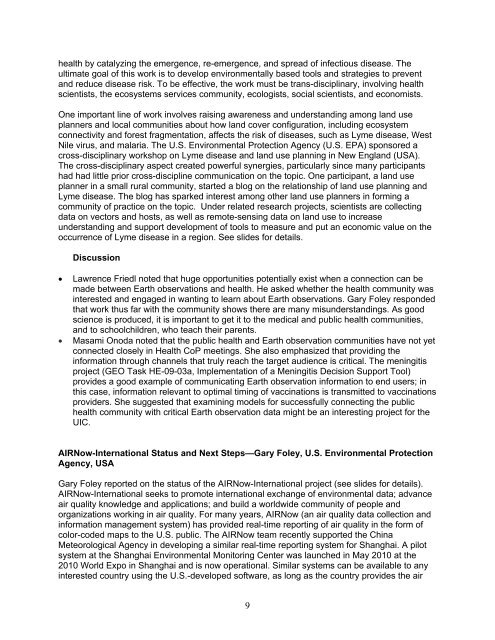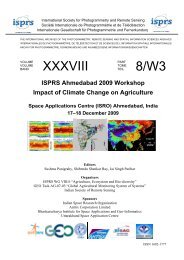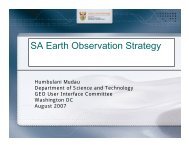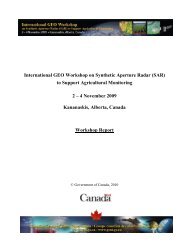GEO UIC Committee: - Group on Earth Observations
GEO UIC Committee: - Group on Earth Observations
GEO UIC Committee: - Group on Earth Observations
You also want an ePaper? Increase the reach of your titles
YUMPU automatically turns print PDFs into web optimized ePapers that Google loves.
health by catalyzing the emergence, re-emergence, and spread of infectious disease. The<br />
ultimate goal of this work is to develop envir<strong>on</strong>mentally based tools and strategies to prevent<br />
and reduce disease risk. To be effective, the work must be trans-disciplinary, involving health<br />
scientists, the ecosystems services community, ecologists, social scientists, and ec<strong>on</strong>omists.<br />
One important line of work involves raising awareness and understanding am<strong>on</strong>g land use<br />
planners and local communities about how land cover c<strong>on</strong>figurati<strong>on</strong>, including ecosystem<br />
c<strong>on</strong>nectivity and forest fragmentati<strong>on</strong>, affects the risk of diseases, such as Lyme disease, West<br />
Nile virus, and malaria. The U.S. Envir<strong>on</strong>mental Protecti<strong>on</strong> Agency (U.S. EPA) sp<strong>on</strong>sored a<br />
cross-disciplinary workshop <strong>on</strong> Lyme disease and land use planning in New England (USA).<br />
The cross-disciplinary aspect created powerful synergies, particularly since many participants<br />
had had little prior cross-discipline communicati<strong>on</strong> <strong>on</strong> the topic. One participant, a land use<br />
planner in a small rural community, started a blog <strong>on</strong> the relati<strong>on</strong>ship of land use planning and<br />
Lyme disease. The blog has sparked interest am<strong>on</strong>g other land use planners in forming a<br />
community of practice <strong>on</strong> the topic. Under related research projects, scientists are collecting<br />
data <strong>on</strong> vectors and hosts, as well as remote-sensing data <strong>on</strong> land use to increase<br />
understanding and support development of tools to measure and put an ec<strong>on</strong>omic value <strong>on</strong> the<br />
occurrence of Lyme disease in a regi<strong>on</strong>. See slides for details.<br />
Discussi<strong>on</strong><br />
• Lawrence Friedl noted that huge opportunities potentially exist when a c<strong>on</strong>necti<strong>on</strong> can be<br />
made between <strong>Earth</strong> observati<strong>on</strong>s and health. He asked whether the health community was<br />
interested and engaged in wanting to learn about <strong>Earth</strong> observati<strong>on</strong>s. Gary Foley resp<strong>on</strong>ded<br />
that work thus far with the community shows there are many misunderstandings. As good<br />
science is produced, it is important to get it to the medical and public health communities,<br />
and to schoolchildren, who teach their parents.<br />
• Masami Onoda noted that the public health and <strong>Earth</strong> observati<strong>on</strong> communities have not yet<br />
c<strong>on</strong>nected closely in Health CoP meetings. She also emphasized that providing the<br />
informati<strong>on</strong> through channels that truly reach the target audience is critical. The meningitis<br />
project (<str<strong>on</strong>g>GEO</str<strong>on</strong>g> Task HE-09-03a, Implementati<strong>on</strong> of a Meningitis Decisi<strong>on</strong> Support Tool)<br />
provides a good example of communicating <strong>Earth</strong> observati<strong>on</strong> informati<strong>on</strong> to end users; in<br />
this case, informati<strong>on</strong> relevant to optimal timing of vaccinati<strong>on</strong>s is transmitted to vaccinati<strong>on</strong>s<br />
providers. She suggested that examining models for successfully c<strong>on</strong>necting the public<br />
health community with critical <strong>Earth</strong> observati<strong>on</strong> data might be an interesting project for the<br />
<str<strong>on</strong>g>UIC</str<strong>on</strong>g>.<br />
AIRNow-Internati<strong>on</strong>al Status and Next Steps—Gary Foley, U.S. Envir<strong>on</strong>mental Protecti<strong>on</strong><br />
Agency, USA<br />
Gary Foley reported <strong>on</strong> the status of the AIRNow-Internati<strong>on</strong>al project (see slides for details).<br />
AIRNow-Internati<strong>on</strong>al seeks to promote internati<strong>on</strong>al exchange of envir<strong>on</strong>mental data; advance<br />
air quality knowledge and applicati<strong>on</strong>s; and build a worldwide community of people and<br />
organizati<strong>on</strong>s working in air quality. For many years, AIRNow (an air quality data collecti<strong>on</strong> and<br />
informati<strong>on</strong> management system) has provided real-time reporting of air quality in the form of<br />
color-coded maps to the U.S. public. The AIRNow team recently supported the China<br />
Meteorological Agency in developing a similar real-time reporting system for Shanghai. A pilot<br />
system at the Shanghai Envir<strong>on</strong>mental M<strong>on</strong>itoring Center was launched in May 2010 at the<br />
2010 World Expo in Shanghai and is now operati<strong>on</strong>al. Similar systems can be available to any<br />
interested country using the U.S.-developed software, as l<strong>on</strong>g as the country provides the air<br />
9







